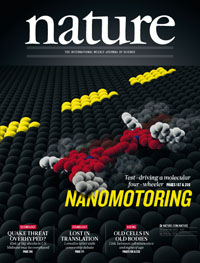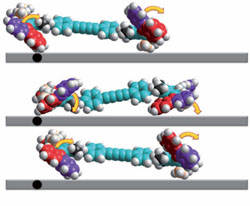Nature cover story: Groningen chemists construct an electrically powered nanovehicle

The cover of scientific journal Nature this week reads Nanomotoring, test-driving a molecular four-wheeler, drawing attention to an article by Groningen chemist Ben Feringa and his research group. The article describes a molecule that does indeed resemble a four-wheel drive vehicle, but that also brings a wondrous insect to mind using four paddle-legs to move about. Electrical energy from the tip of a Scanning Tunnel Microscope (STM) serves to power the vehicle.
The article is exactly what Feringa promised to deliver when he received the Spinoza Prize from NWO in 2004. In 1999 he invented a light-powered molecular motor, a spectacular discovery that drew attention throughout the world. One of his goals with the Spinoza funds and a later ERC grant was to use this motor to propel a molecular vehicle. This vehicle would have to be able to perform a controlled movement across a surface.
Motor as wheel
The 1999 molecular motor consists of two parts: a fixed, static part that can serve as anchor and a unidirectional rotating part that can work as a screw or propeller. It gave rise to the idea that it could function as something like an outboard motor fixed to a larger unit.
However, in the nanovehicle described in Nature, the motor is used as a wheel. The new molecule has a long midsection with four rotating wheels at its corners. Or perhaps it would be better to call them paddles, as the extremities are not completely round. As a result, the vehicle tends to bumble along a bit.
Overhead wire
The four-wheeled molecule receives its power to move from an STM tip that serves as something like a train’s overhead wire. An STM (scanning tunnel microscope) feels its way across a surface with a pointed wire without any actual ‘physical’ contact taking place – the very last bit is bridged by an electrical charge.
The energy from the STM tip ‘tunnels’ into the molecule, which then enters a higher energy level, leading to the wheels turning step by step; this process is analogous to energy transfer by photons.
Wrong direction
In the Nature article STM images show the molecule moving across a copper surface. After ten steps it has moved 6 nanometres in a more or less straight line. To prove that it is indeed the wheels that are propelling it, the researchers show in follow-up experiments what happens when wheels rotate in the wrong direction. The chemists studied molecules where the rear wheels turned in the opposite direction to the front ones, or where the left wheels rotated backwards while the right pair rotated forwards or vice versa. The resulting movements are exactly what you would expect – the molecule hardly shifts position or just zigzags around a bit.
Proof
These last experiments clearly prove that the movement is caused by the wheels rotating, according to the researchers in their conclusion. Perhaps the speed and performance leave something to be desired but the proof has been given: a single molecule with intrinsic motor functions is capable of turning energy delivered from outside into a movement in a single direction across a surface.

Curriculum vitae
In 2004, Prof. B.L. Feringa, professor of synthetic organic chemistry, received an NWO Spinoza Prize, the highest academic award in the Netherlands. In 2008 he was appointed Academy Professor by the Royal Netherlands Academy of Arts and Sciences (KNAW) and received an Advanced Grant from the European Research Council (ERC) for the project ‘Molecular Motors – Controlling movement at the nanoscale’. He has been vice president of KNAW since June 2011.
For more information: Prof. B.L. Feringa
Appendix: video clip of the movement as demonstrated by a molecular model or see YouTube
Reference: Electrically-driven directional motion of a four-wheeled molecule on a metal surface, Tibor Kudernac, Nopporn Ruangsupapichat, Manfred Parschau, Beatriz Maciá, Nathalie Katsonis, Syuzanna R. Harutyunyan, Karl-Heinz Ernst & Ben L. Feringa. Nature, 10 Nov 2011.
DOI: 10.1038/nature10587
| Last modified: | 24 August 2021 3.24 p.m. |
More news
-
03 April 2025
IMChip and MimeCure in top 10 of the national Academic Startup Competition
Prof. Tamalika Banerjee’s startup IMChip and Prof. Erik Frijlink and Dr. Luke van der Koog’s startup MimeCure have made it into the top 10 of the national Academic Startup Competition.
-
01 April 2025
NSC’s electoral reform plan may have unwanted consequences
The new voting system, proposed by minister Uitermark, could jeopardize the fundamental principle of proportional representation, says Davide Grossi, Professor of Collective Decision Making and Computation at the University of Groningen
-
01 April 2025
'Diversity leads to better science'
In addition to her biological research on ageing, Hannah Dugdale also studies disparities relating to diversity in science. Thanks to the latter, she is one of the two 2024 laureates of the Athena Award, an NWO prize for successful and inspiring...
